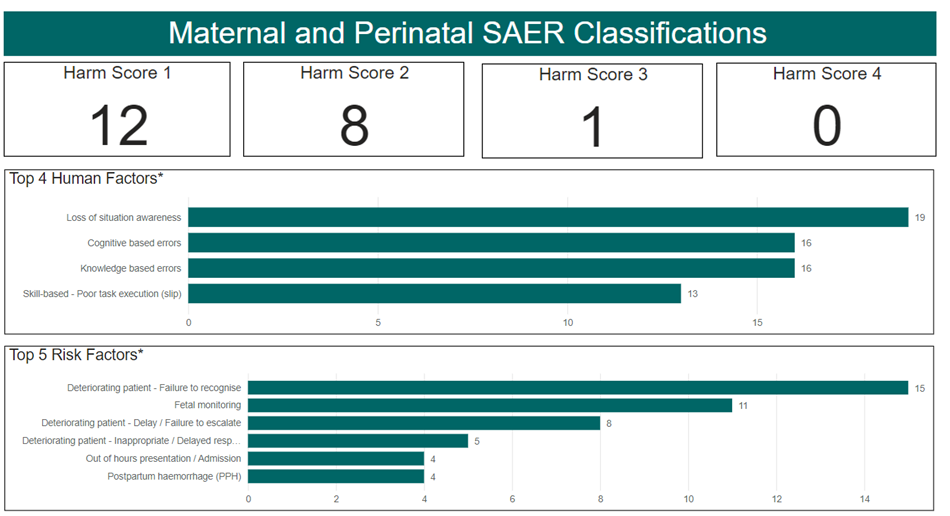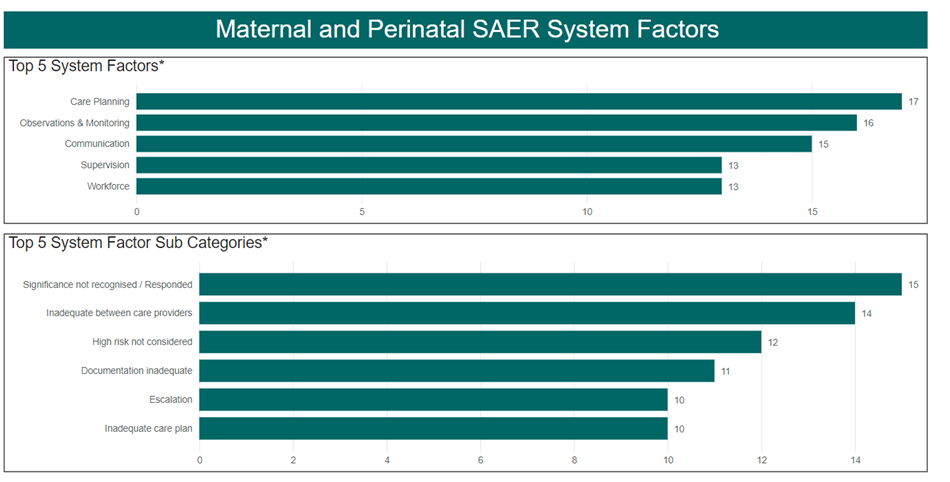Maternal and Perinatal SAER Review Sub-Committee
The Maternal and Perinatal sub-committee reviews SAER reports related to incidents that occur during pregnancy, birth and the postnatal period, including unexpected intra-partum stillbirths, perinatal and maternal deaths.
During the reporting period, the Maternal and Perinatal SAER review sub-committee classified a total of 21 SAER reports. The majority of these reports (57 per cent, n=12) related to Harm Score 1 incidents, followed by Harm Score 2 (38 per cent, n=8) and Harm Score 3 (5 per cent, n=1).
Review of these SAERs identified the human factors elements identified within maternal and perinatal cases related to:
- Loss of situational awareness, relates to the focus on one aspect of care, irrelevant information, poor prioritisation and planning of care
- Cognitive based errors, involving the failure to understand, process or act appropriately on available information despite adequate education and knowledge. This may include following the wrong clinical pathway.
- Knowledge based errors, that are caused by gaps in staff skills or knowledge
- Skill-based – poor task execution, involves the failure to act appropriately on available information, despite adequate knowledge and training
Clinical risk factors relate to conditions or situations that are considered a direct cause, or contributing factor, to the outcome of an incident. The main risk factors identified through review of maternal and perinatal SAER reports include:
- Deteriorating patient – failure to recognise, where patient deterioration was not recognised
- Fetal monitoring, including issues associated with the initiation or removal, ordering, equipment, recording, interpreting of results or escalation of results regarding fetal monitoring
- Deteriorating patient – failure to escalate, where the patient was deteriorating and there were delays and/or failure to escalate care
An overview of Maternal and Perinatal SAER classifications are provided below.
Figure 13.

*Multiple factors can be applied to each SAER
Review of maternal and perinatal SAER reports identified Care Planning, Observations & Monitoring and Communication and as the most frequent system issues affecting care provision.
Since 2013, the category Care Planning has consistently been the most commonly identified system factor in maternal and perinatal SAER investigations. Care planning encompasses a number of issues such as the plan being inadequate to meet the woman's/fetus'/neonate's clinical care requirements; difficulties in organising and planning care within or between teams/ services to ensure timely and integrated patient care; and where care plans were developed but not enacted as required.
The system factor category Observations & Monitoring includes where deterioration in clinical condition was not recognised, escalated and / or acted upon in a timely manner.
Figure 14.

*Multiple factors can be applied to each SAER
